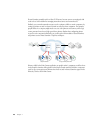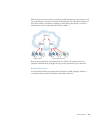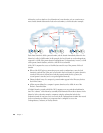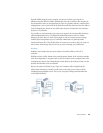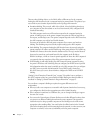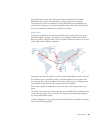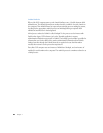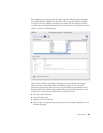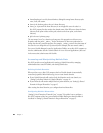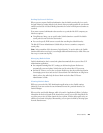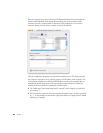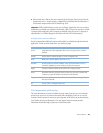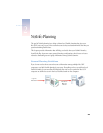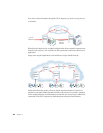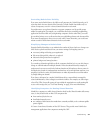24
Chapter 1
m homedirstyletype is used by Server Admin to distinguish among home directory styles
none, local, and custom.
m home is the absolute path to the user’s home directory.
m home_loc is present if the home directory is on an Apple file server. Its value is a
Mac OS X property list that contains the domain name of the AFP server where the home
directory share point resides and the path, relative to the share point, to the home
directory.
m gid is the user’s primary group.
The user named “root” in a domain can change any of its properties or add new ones.
Properties with the prefix “_writers_” list the short names of other users authorized to
change the value of a particular property. For example, _writers_passwd is the short name of
the user who can change this user’s password (in this example, the user named “admin”).
You can use NetInfo Manager, located in /Applications/Utilities, on any Mac OS X computer to
view the administrative data in a NetInfo domain. It is one of several applications (discussed
in the next section) that interact with NetInfo.
Accessing and Manipulating NetInfo Data
Mac OS X provides several applications for setting up NetInfo hierarchies, managing
administrative data stored in NetInfo, and viewing NetInfo data.
Defining NetInfo Domains
When you first set up a Mac OS X computer, the local NetInfo domain is automatically
created and populated. After initial setup, you can create shared domains:
m If your NetInfo hierarchy will consist of only local domains and a root domain, see
“Setting Up the Root Domain of a Simple Hierarchy” on page 44.
m If your hierarchy will contain multiple levels of parent domains, see “Setting Up Shared
Domains in Deeper Hierarchies” on page 45.
After creating the shared domains, you configure them into hierarchies.
Configuring NetInfo Hierarchies
“Setting Up Local Domains of Network Users” on page 51 describes how to configure a
Mac OS X computer to bind to a parent NetInfo domain. Binding two shared domains is
described in “Setting Up Shared Domains in Deeper Hierarchies” on page 45.



